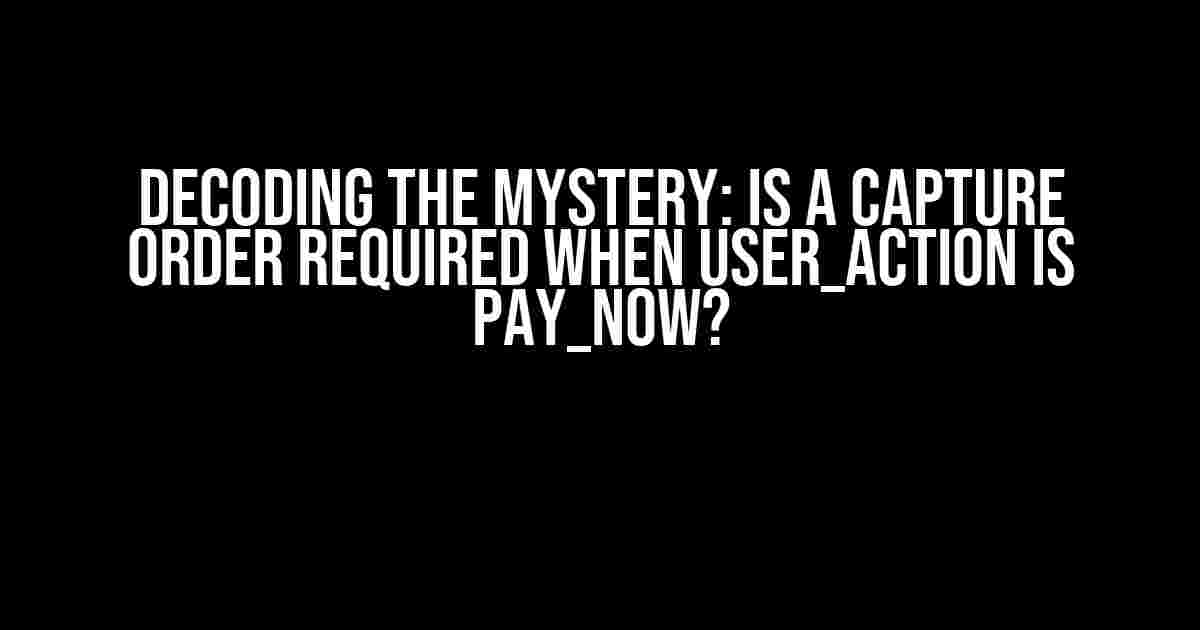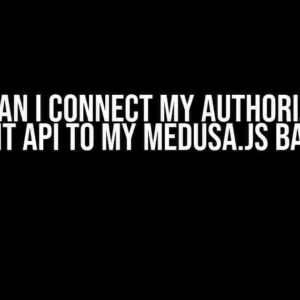Understanding the /v2/checkout/orders Interface
In the world of e-commerce, understanding the intricacies of payment processing is crucial to ensure seamless transactions. One such aspect is the /v2/checkout/orders interface, which plays a vital role in managing orders and payments. In this article, we’ll delve into the specifics of the user_action field and its impact on capture orders when set to pay_now.
What is the user_action Field?
The user_action field in the /v2/checkout/orders interface is a crucial parameter that determines how the payment transaction will be processed. It can take on one of three values: pay_now, authorize, or none. Each value has its own implications on the payment workflow, and in this article, we’ll focus on the pay_now scenario.
When user_action is pay_now: What Happens Next?
When the user_action field is set to pay_now, it indicates that the payment should be captured immediately. But, does this mean a capture order is required? To answer this, let’s break down the payment flow:
- Customer places an order and selects a payment method.
- The merchant’s system sends a request to the payment gateway with the user_action field set to pay_now.
- The payment gateway processes the payment and captures the funds.
- The payment gateway responds to the merchant’s system with a payment token or a success/failure status.
In this scenario, the payment is captured immediately, and no additional capture order is required. The payment gateway takes care of the capture process, and the merchant’s system receives a confirmation of the payment status.
Benefits of Setting user_action to pay_now
Setting the user_action field to pay_now offers several benefits, including:
- Improved conversion rates: By capturing payments immediately, merchants can reduce the likelihood of failed payments due to expired cards or insufficient funds.
- Faster order fulfillment: With immediate payment capture, merchants can process orders faster, leading to quicker delivery times and improved customer satisfaction.
- Reduced fraud risk: Capturing payments immediately reduces the risk of fraudulent activities, as the payment is processed in real-time.
When is a Capture Order Required?
While setting the user_action field to pay_now eliminates the need for a capture order, there are scenarios where a capture order is still required:
- When the payment gateway is unable to capture the payment immediately, a capture order is sent to the merchant’s system to retry the payment capture.
- In cases where the payment gateway supports delayed capture, a capture order is sent to the merchant’s system to capture the payment at a later time.
In these situations, a capture order is necessary to ensure that the payment is captured successfully. The capture order serves as a request to the payment gateway to capture the payment, and it’s essential to handle these orders correctly to avoid payment failures.
Best Practices for Handling Capture Orders
To ensure seamless payment processing, merchants should follow best practices when handling capture orders:
- Implement a retry mechanism: In cases where the payment gateway is unable to capture the payment, implement a retry mechanism to resend the capture order.
- Monitor payment status: Regularly monitor payment status to identify failed payments and take necessary actions to resolve the issues.
- Provide clear communication: Inform customers about payment failures and provide clear instructions on how to resolve the issues.
Conclusion
In conclusion, when the user_action field is set to pay_now in the /v2/checkout/orders interface, a capture order is not required, as the payment is captured immediately by the payment gateway. However, it’s essential to understand the nuances of payment processing and handle capture orders correctly to ensure seamless transactions. By following best practices and staying informed about payment workflows, merchants can optimize their payment processes and improve customer satisfaction.
{
"user_action": "pay_now",
"payment_method": "credit_card",
"amount": {
"currency": "USD",
"value": 100.00
}
}
The code snippet above illustrates an example of a payment request with the user_action field set to pay_now. By understanding the implications of this field, merchants can optimize their payment workflows and improve customer satisfaction.
| user_action Value | Description | Capture Order Required? |
|---|---|---|
| pay_now | Immediate payment capture | No |
| authorize | Delayed payment capture | Yes |
| none | No payment capture | No |
The table above summarizes the user_action field values and their implications on capture orders. By understanding the differences between these values, merchants can optimize their payment workflows and improve customer satisfaction.
FAQs
Q: What happens if the payment gateway is unable to capture the payment immediately?
A: In cases where the payment gateway is unable to capture the payment immediately, a capture order is sent to the merchant’s system to retry the payment capture.
Q: Can I set the user_action field to pay_now for all payment methods?
A: No, not all payment methods support immediate payment capture. It’s essential to check the payment method’s capabilities before setting the user_action field to pay_now.
Q: How do I handle failed payment captures?
A: Implement a retry mechanism, monitor payment status, and provide clear communication to customers to resolve payment failures.
By understanding the intricacies of the user_action field and its impact on capture orders, merchants can optimize their payment workflows and improve customer satisfaction. Remember, a clear understanding of payment processing is key to ensuring seamless transactions.
Frequently Asked Question
Get the inside scoop on PayPal’s /v2/checkout/orders interface and the role of user_action in determining capture orders!
What happens when the user_action field is set to pay_now in the /v2/checkout/orders interface?
When the user_action field is set to pay_now, it means the buyer intends to pay immediately. In this case, a capture order is indeed required to complete the payment transaction.
Is it possible to set the user_action field to pay_now and not require a capture order?
No, when user_action is pay_now, a capture order is mandatory. This ensures the payment is processed and completed in a single step.
What happens if I don’t capture the order after setting user_action to pay_now?
If you don’t capture the order, the payment will not be completed, and the buyer’s funds will not be transferred. This can lead to a poor user experience and potential issues with order fulfillment.
Can I update the user_action field from pay_now to another value after the order is created?
No, once the user_action field is set to pay_now, it cannot be updated. You must capture the order or cancel it if needed.
What are the consequences of not capturing an order with user_action set to pay_now?
Failure to capture an order with user_action set to pay_now may result in order cancellation, disputes, or chargebacks. It’s essential to capture the order to complete the payment transaction and ensure a smooth buyer experience.


